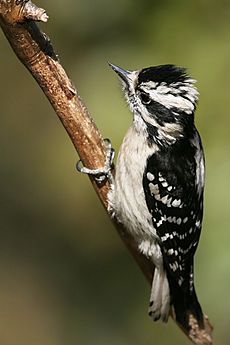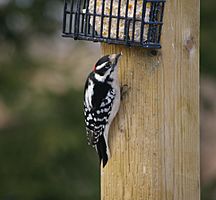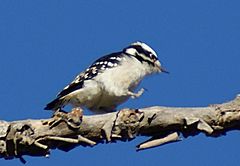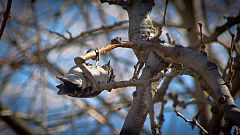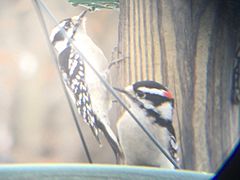Downy woodpecker facts for kids
The downy woodpecker (Dryobates pubescens) is a small and common woodpecker found across North America. It's the smallest woodpecker on the continent. These birds are known for their black and white feathers and their drumming sounds on trees. You can often spot them in forests, parks, and even your backyard!
Quick facts for kids Downy woodpecker |
|
|---|---|
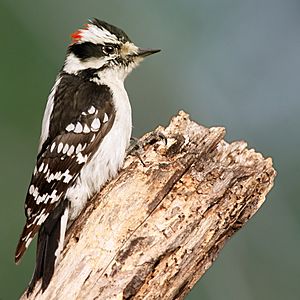 |
|
| Male downy woodpecker | |
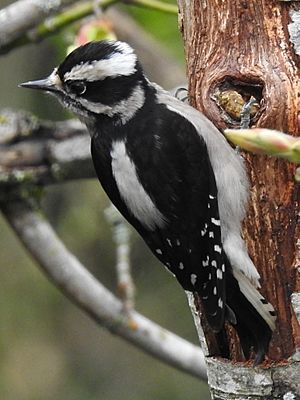 |
|
| Female downy woodpecker | |
| Conservation status | |
| Scientific classification | |
| Genus: |
Dryobates
|
| Species: |
pubescens
|
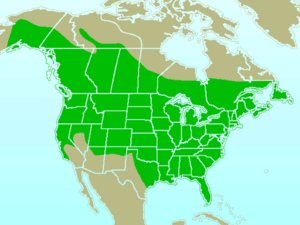 |
|
| Where downy woodpeckers live | |
| Synonyms | |
|
|
Contents
What is a Downy Woodpecker?
Downy woodpeckers are small birds, usually about 14 to 18 centimeters (5.5 to 7 inches) long. Their wings can spread up to 31 centimeters (12 inches) wide. They weigh about 20 to 33 grams (0.7 to 1.2 ounces), which is about the same as a few quarters!
How to Spot a Downy Woodpecker
These woodpeckers are mostly black and white. Their backs and wings are black, but they have a white stripe down their back. Their throat and belly are also white. Their wings have white spots, and they have white stripes above and below their eyes. Their tail is black with some white outer feathers that have black bars.
A cool way to tell male and female downy woodpeckers apart is by looking at their heads. Adult males have a small red patch on the back of their heads. Young birds, called juveniles, might have a red cap on their heads. The female does not have any red on her head.
Downy vs. Hairy Woodpecker
Downy woodpeckers look a lot like hairy woodpeckers, but there are a few key differences. The downy woodpecker is much smaller. Also, the downy woodpecker has black spots on its white outer tail feathers. The hairy woodpecker does not have these spots.
Another big clue is their beak. The downy woodpecker's beak is short, shorter than its head. The hairy woodpecker's beak is much longer, about the same length as its head. Even though they look alike, they are not closely related. This is an example of convergent evolution, where different species develop similar traits.
Sounds and Communication
Downy woodpeckers make several different sounds. One common sound is a short "pik" call. If you hear four "piks" with about half a second between each, it might be a downy woodpecker!
They also make a "rattle-call," which sounds like a bouncing ball. Like other woodpeckers, they also "drum" on trees with their beaks. This drumming is a way for them to communicate, like marking their territory or attracting a mate. Their drumming sounds like four slow taps.
Where Do Downy Woodpeckers Live?
Downy woodpeckers live in forests across most of the United States and Canada. They especially like forests with deciduous trees, which are trees that lose their leaves in the fall. You won't find them in very dry desert areas or the cold, treeless tundra in the far north.
Most downy woodpeckers stay in the same area all year round. However, some birds from colder northern regions might fly south for the winter. Those living in mountains might move to lower areas where it's warmer.
What Do Downy Woodpeckers Do?
Downy woodpeckers are busy birds! They build their nests inside holes they dig in dead trees or tree branches. In winter, they also use these tree holes to rest and stay warm.
What Do They Eat?
These woodpeckers mostly eat insects. They search for food on tree bark, picking insects off the surface in summer. In winter, they dig deeper into the wood to find hidden insects. They also eat seeds and berries.
One important job they do is eating the European corn borer. This moth is a pest that causes a lot of damage to corn crops. By eating these pests, downy woodpeckers help farmers!
Visiting Your Backyard
In winter, downy woodpeckers often visit suburban backyards, especially if there are mature trees around. They love to eat suet (a type of bird food made from fat) and shelled peanuts from bird feeders. If you put out a feeder, you might get to see these busy little birds up close!
Gallery
Images for kids
See also
 In Spanish: Pico pubescente para niños
In Spanish: Pico pubescente para niños



